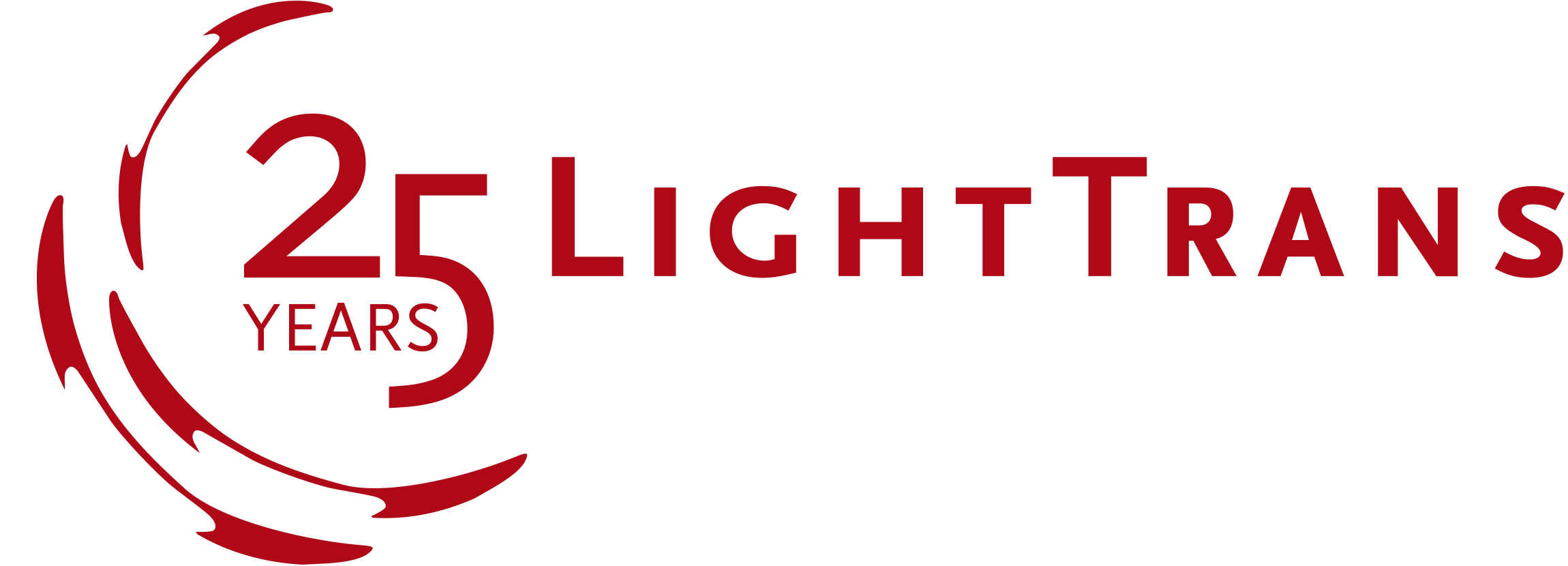OptoNet Summer Course
Fast Physical Optics Modeling and Design
11 – 15 September 2023
09:00 – 16:30 (CEST)
Technologie- und Innovationspark
Moritz-von-Rohr-Straße 1a, 07745 Jena, Germany
Book here
Introduction
The demand for physical optics simulation technology has grown distinctly to the point where, for many applications in modern optics, it simply cannot be avoided. Switching to a physical optics model only in those parts of the system where ray tracing is not expected to be an accurate option risks missing important information about the system, mainly due to the mutually incompatible mathematical models – rays and electromagnetic fields. Furthermore physical-optical effects may also be relevant in other parts of the system were they were in principle not expected. This is the justification behind the proposal for a ›fast physical optics‹ approach: a physical optics technique which includes a generalization of ray tracing fully embedded inside the overarching physical optics framework, and which, consequently, provides physical optics simulation results just as fast as ray tracing.
In the OptoNet Summer Course Fast Physical Optics Modeling and Design, we will equip you with the necessary theoretical and practical knowledge to make the most of your work with the fast physical optics software VirtualLab Fusion!
Programm & Training Concept
Physical optics simulation tools & technology are a must-have for the analysis and design of modern systems. In this course we will be employing the commercial fast physical optics modeling and design software VirtualLab Fusion to investigate a series of optical systems taken from a broad range of fields of application. We will use these examples to introduce the most important features and details of the underlying technology of the software, from a very general perspective in the first two introductory days, and with a focus on gratings as just one part of larger, more complex optical systems in the advanced course covering the last three days. New features and changes in the latest software will of course be covered within this course.
Some of the topics you can expect to hear about: interferometry, lens systems, anisotropy, fiber coupling, ultrashort pulses, meta gratings, augmented and mixed reality lightguides, and more!
Participation Requirements & Modules
This course is designed for optical scientists, engineers, designers with varying levels of expertise with VirtualLab Fusion in mind, starting from total beginners.
- Introduction: This two-day course provides an overview of VirtualLab Fusion’s fast physical optics usage and technology, and shows how to apply said technology to a series of examples from a varied range of applications. Beginner to intermediate level.
- Gratings and AR & MR: This more advanced three-day course focuses on gratings, starting with the many tools available in VirtualLab Fusion to configure very different types of gratings, as well as to characterize and optimize gratings as standalone components (including metagratings); it will then moved on to include those gratings in more complex systems, where the gratings will be accompanied by other optical components. In the following part, as a notable application example,some time will be devoted to the modeling and design of lightguide devices with grating couplers for augmented and mixed reality applications. Advanced level.
- Both: The content of the courses has been designed so that it is possible to register for either of them separately, or to book both of them together.
Note: Please bring your own notebook, the required software will be provided by the organizer.
Agenda
Monday, 11 September 2023 | Introduction I – IV
08:30 – 09:00 Welcome & registration
09:00 – 10:30 Part I
- Why physical optics? The philosophy behind VirtualLab Fusion.
- Field tracing enables fast physical optics. Key aspects of the technology.
- Building your first optical system with VirtualLab Fusion.
- Our flexible detector concept.
10:45 – 12:15 Part II
- The role of the Fourier transform in the simulation of diffraction. The catalog of algorithms for the calculation of the Fourier transform.
- Diffraction integrals. The Poisson spot.
- Controlling the selection of Fourier transform algorithms. Automatic selection or tailored configuration. Switching diffraction on and off.
- Modeling of pinhole in system with low Fresnel number.
- Foucault’s knife-edge experiment.
12:15 – 13:15 Lunch
13:15 – 14:45 Part III
- The importance of positioning.
- Non-sequential simulations. The Light Path Finder. The channel concept. Master channels.
- Modeling of etalon.
- Examination of sodium D lines with Fabry-Perot etalon.
- Investigation of ghost image effects in collimation system.
15:00 – 16:30 Part IV
- Grating order channels.
- Lateral channels – lightguides and microlens arrays.
- Simulation of light propagation behind microlens array.
- Simulation of a Shack-Hartmann sensor.
Tuesday, 12 September 2023 | Introduction V – VIII | Welcome Dinner
09:00 – 10:30 Part V
- Advanced positioning. Interferometry.
- Experiments with a Mach-Zehnder – complementary interference pattern caused by prism beam splitter, observation of the Gouy phase shift, generation of spatially varying polarization.
10:45 – 12:15 Part VI
- Connecting field solvers as the only way to tackle complex optical systems.
- Overview of the current catalog of electromagnetic field solvers in VirtualLab Fusion.
- Abbe’s image resolution experiment.
- Optical system for investigation of microstructured wafer.
- Birefringence in calcite block. Complex polarization effects in uniaxial crystals. Conical refraction in biaxial crystals.
- Selecting your solver. Simulation of tunnelling effect through air gap in prism beam splitter.
12:15 – 13:15 Lunch
13:15 – 14:45 Part VII
- Advanced source modeling – the source mode concept.
- White light Michelson interferometer.
- Demonstration of optical tomography scanning with Michelson. Partial temporal coherence.
- Young’s double-slit experiment with an extended source.
- Propagation of ultra-short pulse through high-NA lens.
- Simulation of Talbot effect with unpolarized light.
- Modeling of VCSELs and VCSEL arrays.
15:00 – 16:30 Part VIII
- Convenience tools. Parametric optimization.
- Analysis and optimization of fiber-coupling set-up.
- Q & A
19:00 Welcome Dinner
Wednesday, 13 September 2023 | Gratings I – IV
09:00 – 10:30 Part I
- Grating configuration and modeling.
- Grating structure specification.
- Electromagnetic field solvers for gratings in VirtualLab Fusion (Thin Element Approximation, TEA, and Fourier Modal Method/Rigorous Coupled Wave Analysis, FMM/RCWA).
- Convenience tools for grating analysis.
10:45 – 12:15 Part II
- Rigorous modeling examples.
- Blazed grating for spectral separation.
- Ultrasparse dielectric nano-wire grid polarizers.
- Parameter sweeping tool.
12:15 – 13:15 Lunch
13:15 – 14:45 Part III
- More examples of rigorous modeling.
- Simulation and analysis of slanted gratings with varying parameters.
- Volume holographic gratings and their sensitivity.
15:00 – 16:30 Part IV
- Gratings within optical systems.
- Angular-filter volume grating for higher diffraction order suppression.
- Resonant waveguide grating and its angular/spectral properties.
- Using gratings as test objects in imaging systems. Optical system for investigation of microstructured wafer.
Thursday, 14 September 2023 | Gratings V – VIII
09:00 – 10:30 Part V
- Grating design/optimization.
- Optimization of slanted gratings for waveguide coupling.
- Parametric optimization tool.
10:45 – 12:15 Part VI
- More grating design and optimization.
- Design of polarization-independent high-efficiency gratings.
- Design of antireflection moth-eye structures.
12:15 – 13:15 Lunch
13:15- 14:45 Part VII
- Metagratings.
- Rigorous analysis of nanopillars as metasurface building blocks.
- Design of a blazed metagrating.
15:00 – 16:30 Part VIII
- Metagratings.
- Beam-splitting metagrating design.
- IFTA for phase profile generation.
Friday, 15 September 2023 | Gratings IX – XII
09:00 – 10:30 Part IX
- Configuration of lightguide devices for augmented and mixed reality applications with grating couplers.
- Idealized versus real gratings.
10:45 – 12:15 Part X
- Modeling of different lightguide geometries.
- K-layout representation.
- Simulation of different physical optics effects in lightguides (polarization, coherence, diffraction…)
12:15 – 13:15 Lunch
13:15 – 14:45 Part XI
- Systematic design tools for lightguide devices and their grating regions.
- Smooth modulation of grating parameters and subsequent optimization.
- Comparison with parametric optimization of segmented regions.
15:00 – 16:30 Part XII
- General Q & A.
16:30 – 17:00 Feedback & Farewell
Trainers

Olga Baladron-Zorita
Senior Optical Engineer
Olga Baladron-Zorita is employed as a Senior Optical Engineer at LightTrans International. Among other tasks, she conducts webinars and training courses based on VirtualLab Fusion.




